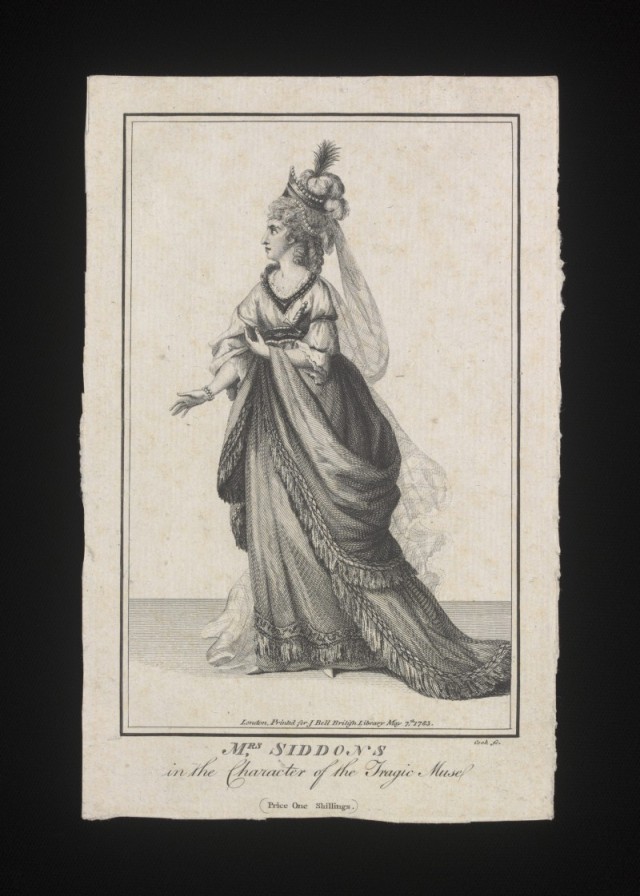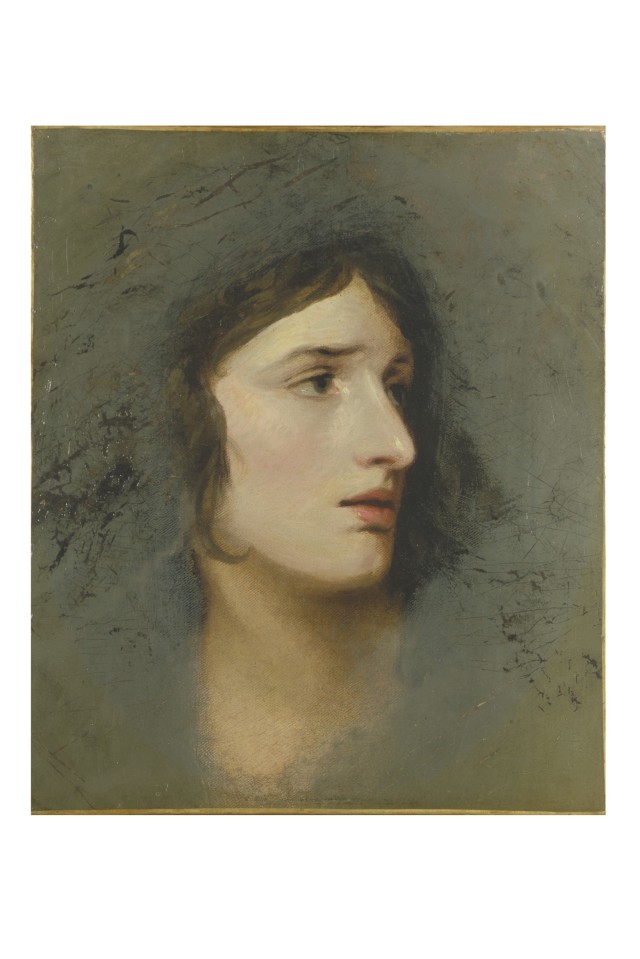“Perhaps in the next world women will be more valued than they are in
this.”
SARAH SIDDONS (1755 - 1831)
SARAH SIDDONS (1755 - 1831)
Self-portrait by Sarah Siddons, plaster bust c 1820 ©
Victoria and Albert Museum
PART FOUR - A Woman's Tragedy continued
Sarah
Siddons had to bear the worst tragedy that can befall a mother, the
death of a child, five times. Two of them died in infancy, an expected
mortality rate for the time, but she gave the impression that only pouring her grief into acting enabled her to endure the losses of
two grown up daughters, one aged only nineteen, and of her eldest son
when he was forty, all due to lung diseases. Two children, a son and a daughter, survived her.
As
a conscientious mother, Mrs Siddons' instinct was to protect her
daughters from the devil's profession of acting; as an actress, to
protect herself from competition. She and William Siddons were anxious
to secure conventional respectable lives for all their children. Only Henry, the
eldest, became an actor. Their younger son, George, was a godson of the
Prince of Wales, later George IV, and entered the Indian Civil Service.
Due to their mother's successful career, the girls were not brought up in expectation of having to work for a living. Mrs Siddons provided for them all their lives.
All three girls were articulate, attractive, self-assertive and strong-willed, raised in a cultured household, conversing with the leading writers, artists and actors of the day. The eldest, Sarah Martha, known to the family as Sally, was reputed to be an accomplished song-writer. Weakening health cut short any professional aspirations of the two elder girls, and the youngest was brought up from the age of nine to be her mother's companion and solace in retirement, a sacrifice made without complaint or surrender of individuality; after Mrs Siddons' death, with her comfortable inheritance, she lived an active and happy life.
Her daughters were not downtrodden; they respected their mother and her career; the highly intelligent eldest and youngest daughters were protective of her professional creative needs, which included being spared emotional upset at home.
Like other loving mothers, the only thing Sarah Siddons, the prophetess of emotion on stage, could not save her daughters from was their own feelings. Sally never blamed her mother for the part she played in the psychological drama - it wasn't a love story - with Thomas Lawrence that overwhelmed all of them.
Initially, Mrs Siddons was too blinded by her own affection for Lawrence to see the whirlpool into which he was pulling them; she was enjoying the undercurrent too much, that his confused feelings were flowing towards her, not her daughters.
The Gipsy Girl by Thomas Lawrence, oil on canvas, 1794
© Royal Academy of Arts, London
A disturbing piece of erotica by Lawrence, for which Maria Siddons, aged fifteen, has been suggested as the model. It is a plausible theory: she has the intense, dark eyed and tousle-headed look of her family, and the date fits with their period of intimacy. The genre to which the picture belongs in art history is "fancy", a sentimental objectification of rural life for rich people, but this wild, half-naked, boyish girl with her flushed cheeks, parted lips and fierce gaze, is inviting a far more sexually ambivalent response, begging tough questions about what on earth Lawrence wanted out of the Siddons sisters.
© Royal Academy of Arts, London
A disturbing piece of erotica by Lawrence, for which Maria Siddons, aged fifteen, has been suggested as the model. It is a plausible theory: she has the intense, dark eyed and tousle-headed look of her family, and the date fits with their period of intimacy. The genre to which the picture belongs in art history is "fancy", a sentimental objectification of rural life for rich people, but this wild, half-naked, boyish girl with her flushed cheeks, parted lips and fierce gaze, is inviting a far more sexually ambivalent response, begging tough questions about what on earth Lawrence wanted out of the Siddons sisters.
Mrs Siddons was in her early forties, still slim and splendidly handsome, at an age when the most famous actress in the country needed assurance that she could still be loved as a woman, not just a national monument. It was never a sexually consummated love affair; it was more of a self-dramatization for the suppressed bisexual, celebrity-obsessed Lawrence to fulfill an impossible dream of union with the irreproachably moral mother-goddess Mrs Siddons.
Sarah Siddons and members of her family by Richard James Lane, published by Joseph
Dickinson, after Sir Thomas Lawrence, lithograph, published May 1830
© National Portrait Gallery, London.
© National Portrait Gallery, London.
Sketching her informally at home in 1798, at the time he was trying to marry one of her daughters, Lawrence saw the actress as a classical deity of brooding potency with three of her children and one of her younger brothers revolving like satellites around her. Clockwise: Cecilia Combe (née Siddons); Sarah Siddons (née Kemble); Maria
Siddons; George John Siddons; Charles Kemble (actor)
Lawrence was fourteen years younger than Mrs Siddons and ten years older than her daughter Maria, who was a lusciously pretty sixteen year old when he started courting her after ditching the elder sister. Both girls shared the intense dark-eyed good looks and striking features of their mother; they were mini-Sarah Siddonses.
A generational pattern was being repeated: Sarah Kemble had been a headstrong fifteen year old when she promised herself to William Siddons, an actor eleven years older than her in her father's touring company. Roger Kemble was so disapproving that he dismissed his daughter, despite her obvious talent, and sent her into service, to no avail, because the determined lovers married two years later.
Mrs Siddons supported what she believed was true love, joining Lawrence and Maria's fight to overcome William Siddons' opposition to an engagement until they wore him down. He looks tired in Opie's portrait. A few weeks after pledging his troth to Maria, Lawrence broke the news to Mrs Siddons that he had changed his mind again, and wanted to marry her elder daughter. She was sympathetic; she understood the play of passions in an artistic temperament. A few months after that, Maria was dead.
Lawrence was the only other man apart from her husband who aroused such reckless feelings in her; he was a soulmate, and they had a rapport that was never broken, even after Maria and Sally's deaths; in old age, she said she wanted Lawrence to be a pallbearer at her funeral. They were part of each other's myth.
It says a lot about the devotion and respect that Sarah Siddons commanded from people, and even more about the steadfast character of her eldest daughter, that Sally did not utter or write a word of reproach against the mother she adored.
Money was important to Mrs Siddons, as it was to a self-made man like Lawrence. Contemporaries, wanting artists to live on inspiration alone, sneered at their materialism. Formative experiences had made both of them terrified of penury. She was understandably jealous of her value in a male-dominated market. Her notorious meanness about appearing for other actors’ benefits is contradicted by the numerous charity performances she gave after her official retirement, not always for members of her own family. Her celebrity and relative affluence for a self-employed actress made her a target for caricaturists, and, finding no other vices in her, they aimed at her supposed avarice.
Print by Gillray, Theatrical Mendicants, relieved,
published 1809. Sarah Siddons and her brothers Charles Kemble and John
Philip Kemble begging for money to rebuild Covent Garden Theatre. Mrs
Siddons appears as a more forceful masculine presence than her fawning
brothers; even in caricature, she retains dignity © Victoria and Albert
Museum.
The esteem in which Mrs Siddons was held by the public and critics was higher than that of any other actor, male or female, but her brother John Philip Kemble was given grander honours on his official retirement than she had on hers. Stung by this proof of the difference in the official status of male and female actors, Mrs Siddons remarked that "perhaps in the next world women will be more valued than they are in this”.

Mrs Siddons in the Character of the Tragic Muse engraved by Cook,
1783. © Victoria and Albert Museum. She walks regally into the next
world, as the most famous tragedienne in English-speaking history










